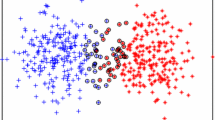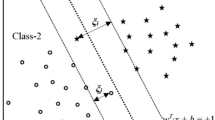Abstract
The theory of machine learning in Banach space is a new research topic and has drawn much attention in recent years. The theoretical foundation of this topic is that under what conditions two sample sets can be separated in Banach space. In this paper, motivated by developing new support vector machine (SVM) in Banach space, we present a necessary and sufficient condition of separating two finite classes of samples by a hyper-plane in Banach space. We also present an attainable expression of maximal margin of the separating hyper-planes which includes some cases of the classes of infinite samples in Banach space.
Similar content being viewed by others
References
Bennett K, Bredensteiner E (2000) Duality and geometry in SVM classifiers. In: Proceedings of the 17th international conference on machine learning, San Francisco, USA, pp 57–64
Bern M, Eppstein D (2001) Optimization over zonotopes and training support vector machines. Lect Notes Comput Sci 2125:111–121
Burges CJC (1998) A tutorial on support vector machines for pattern recognition. Data Min Knowl Disc 2:121–167
Ding GG (1999) Introduction to Banach space. Science Press, Beijing
Hein M, Bousquet O, Scholkopf B (2005) Maximal margin classification for metric spaces. J Comput Syst Sci 21:333–359
Der R, Lee D (2007) Large-margin classification in Banach spaces. In: Proceedings of the 11th international conference on artificial intelligence and statistics, San Juan, Puerto Rico, pp 91–98
Luxburg U, Bousquet O (2004) Distance-based classification with Lipschitz functions. J Mach Learn Res 5:669–695
Osuna E, Castro OD (2002) Convex hull in feature space for support vector machines. In: Lecture notes in computer science. Proceedings of the 8th Ibero-American conference on AI, Seville, Spain, pp 411–419
Minh HQ, Hofmann T (2004) Learning over compact metric spaces. In: Lecture notes in artificial intelligence, vol 3120, pp 239–254
Rockafellar RT (1970) Convex analysis. Princeton University Press, Princeton
Schaefer HH (1971) Topological vector spaces. Springer, Berlin
Schölkopf B, Smola A (2002) Learning with kernels. The MIT Press, Cambridge
Taylor AE, Lay CD (1980) Introduction to functional analysis, 2nd edn. Wiley, New York
Vapnik VN (1998) Statistical learning theory. Wiley, New York
Vapnik VN (2000) The nature of statistical learning theory. Springer, New York
Vapnik VN (1999) An overview of statistical learning theory. IEEE Trans Neural Netw 10(5):988–999
Wu C, Ma M (1991) Embedding problem of fuzzy number space: part I. Fuzzy Sets Syst 44:33–38
Yosida K (1980) Functional analysis, 6th edn. Springer, Berlin
Zadeh LA (1973) Outline of a new approach to the analysis of complex systems and decision processes. IEEE Trans Syst Man Cybern SMC -3:28–44
Zhou D, Xiao B, Zhou H, Dai R (2002) Global geometry of SVM classifiers. In: Technical Report 30 May 2002. Institute of automation, Chinese Academy of Sciences, Beijing
Huang GB, Chen YQ, Babri HA (2000) Classification ability of single hidden layer feed forward neural networks. IEEE Trans Neural Netw 11:799–801
Huang GB, Ding X, Zhou H (2010) Optimization method based extreme learning machine for classification. Neurocomputing 74:155–163
Acknowledgments
This work is partly supported by National NSFCs (61070242), by the Natural Science Foundation of Hebei Province (F2010000323), by the Scientific Research Project of Department of Education of Hebei Province (2009410), by Scientific Research Project of Hebei University (09265631D-2), and by 2010 Baoding science Research and Development Project (10ZG008).
Author information
Authors and Affiliations
Corresponding author
Rights and permissions
About this article
Cite this article
He, Q., Wu, C. Separating theorem of samples in Banach space for support vector machine learning. Int. J. Mach. Learn. & Cyber. 2, 49–54 (2011). https://doi.org/10.1007/s13042-011-0013-4
Received:
Accepted:
Published:
Issue Date:
DOI: https://doi.org/10.1007/s13042-011-0013-4




